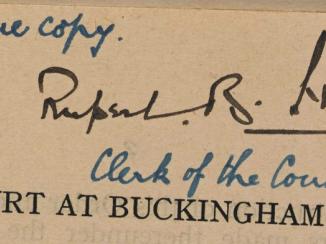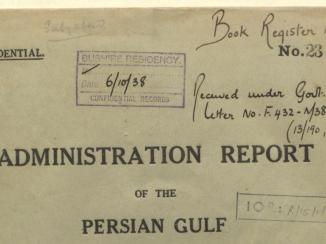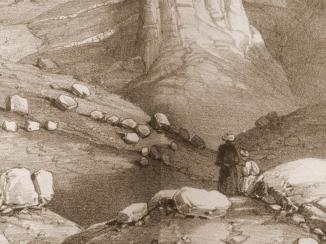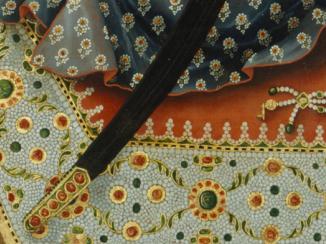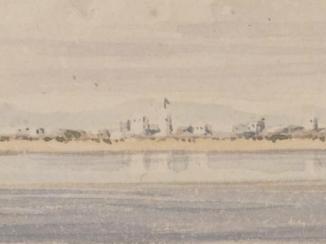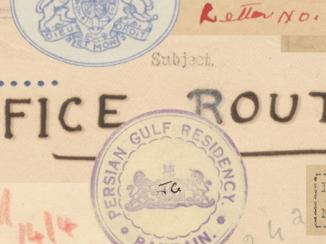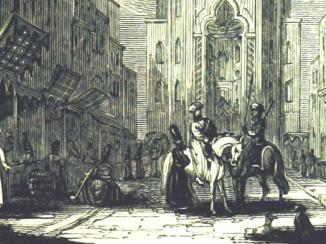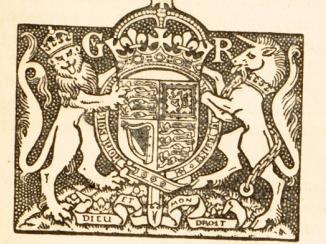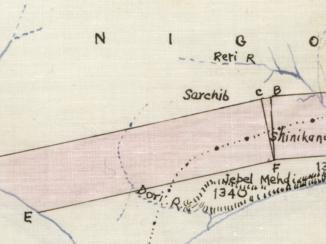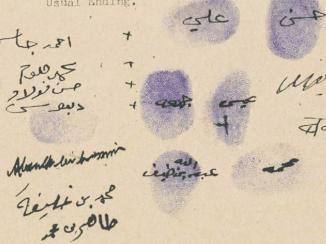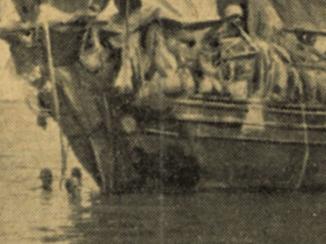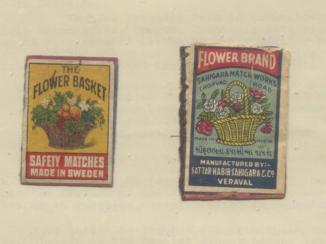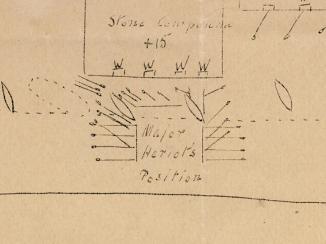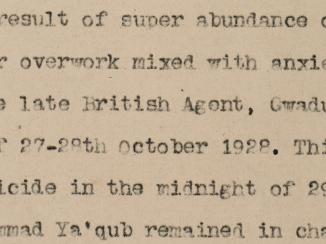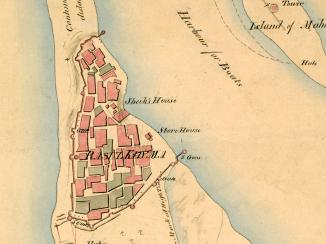Overview
Introduction
The Bushire Residency An office of the East India Company and, later, of the British Raj, established in the provinces and regions considered part of, or under the influence of, British India. Diary for 1805-06 was one of the first items to be catalogued as part of the British Library Qatar Foundation Partnership. The volume contains a record of the East India Company’s activities at Bushire (Bushehr) during those two years, and presents a number of challenges for the cataloguer (and equally for the researcher). These can be categorised as physical, palaeographical, and contextual problems.
The Record
Unlike other eighteenth and nineteenth-century letter books in the collection, the volume (IOR/R/15/1/8) is in diary format. It contains regular entries recording the arrival and departure of East India Company ships and other vessels at Bushehr, and copies of the correspondence sent and received by the (Acting) Resident, William Bruce. There are four Bushehr Residency An office of the East India Company and, later, of the British Raj, established in the provinces and regions considered part of, or under the influence of, British India. diaries in all, covering the years from 1803 to 1807.
Physical problems
The original volume was probably treated during the 1980s. All leaves were laminated with a heat-set tissue and mounted onto guards, then bound into a post book. This method of conservation would not be employed today, but it has at least made it possible to handle and catalogue the volume without causing any further damage. One of the most prominent conservation issues consists of a hole, approximately 60 x 50mm, which appears toward the top of the first folio in the volume. The hole runs through the next eight folios, and has caused the loss of original text from a total of eighteen pages. It is not a totally straightforward task to identify the agent of this damage, but termites would be a good guess.
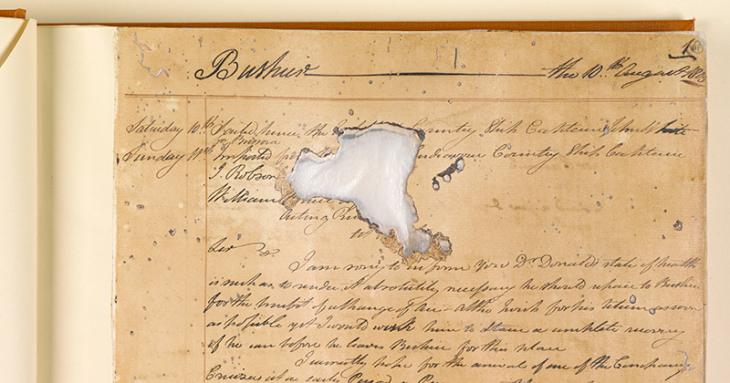
The volume has suffered from further pest damage, in the form of hundreds of pinprick-sized holes on a number of folios. This is the result of the gallery drilling of insect larvae on their way out from the place where the eggs had been laid. It is impossible to say with certainty what species of insect caused the damage, although there seems to be some evidence of furniture beetle action, and it may have occurred either at the volume’s original location in Bushehr, or later, when the records were transported to India.
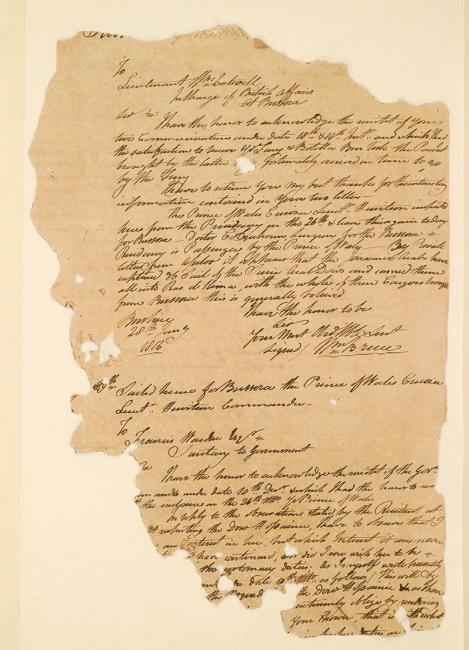
Some of the lost text is difficult to reconstruct, but the damage is partly offset by the Diary’s formulaic nature. Thus, the note on folio 1r stating that the ‘[E]ndeavour, Country Ship, Captain J Robson’, had arrived (‘imported’) on 11 August 1805, is lacking only the name of the port from which the ship had sailed, and the first letter of the ship’s name. The entry is balanced by the note on folio 2r, stating that the same vessel with the same captain had ‘sailed hence for the Presidency The name given to each of the three divisions of the territory of the East India Company, and later the British Raj, on the Indian subcontinent. [of Bombay]’ on 15 August.
Similarly, on folio 2v, only the formal conclusion to a letter, containing the words ‘Yours most obediently’ and the forename of William Bruce have been lost. A small amount of text is also missing from the edges of the volume, but the condition of the paper here has been successfully stabilised. The pest damage is minor and causes few problems, although other letter books in the collection have been more seriously affected.
Palaeographical problems
The handwriting in the volume is somewhat difficult to read. The letters e, r, and s in particular are often hard to distinguish from one another. These letters, in combination with m, n, and w, often produce the appearance of a succession of minims (simple downward strokes in handwriting) which can make proper nouns in particular difficult to decipher.

The long s also appears in the volume; although near the end of its life in printed English, this form of the letter survived in handwriting until as late as the 1860s. The writing is further complicated by renderings and spellings of Arabic and Persian personal and place names that now appear somewhat unusual: for example, Joasimee for Qawasim One of the ruling families of the United Arab Emirates; also used to refer to a confederation of seafaring Arabs led by the Qāsimī tribe from Ras al Khaima. , Bussora for Basra, Bushier for Bushehr, and Bunder Abassee for Bandar ‘Abbas (used alongside the traditional English name for Bandar ‘Abbas, Gombroon, which also appears as Gombaroon).
Contextual problems
Dates appear at the top of the pages in the volume, but if there are subsequent entries on the same page their dates are entered in the left-hand margin. Some of the terminology employed in the diaries is unusual: the verb import, for instance, is used intransitively for a ship meaning ‘to come in to port’, as in the phrase ‘Imported from Bussora the H.C. Ship Ternate, Captn. Thomas Skinner’ (f. 9v). Similarly, the word exported is employed in the opposite sense of ‘sailed hence’ in the Diary for 1803 (IOR/R/15/1/6). Neither of these usages is actually recorded in the Oxford English Dictionary (OED).

The term Country Ship is a specialist term used to describe privately-owned merchant ships, which operated from around 1790 under licence from the East India Company. The word botella occurs as well, and is used to refer to a small dhow A term adopted by British officials to refer to local sailing vessels in the western Indian Ocean. .
High-resolution digital copies
While some older India Office The department of the British Government to which the Government of India reported between 1858 and 1947. The successor to the Court of Directors. records can be challenging to work with, their historical value is indisputable. The high-resolution digital copies made available on the Qatar Digital Library are particularly useful for deciphering handwriting, and give us the opportunity to develop a fuller understanding of the records that comes with patience and experience.





